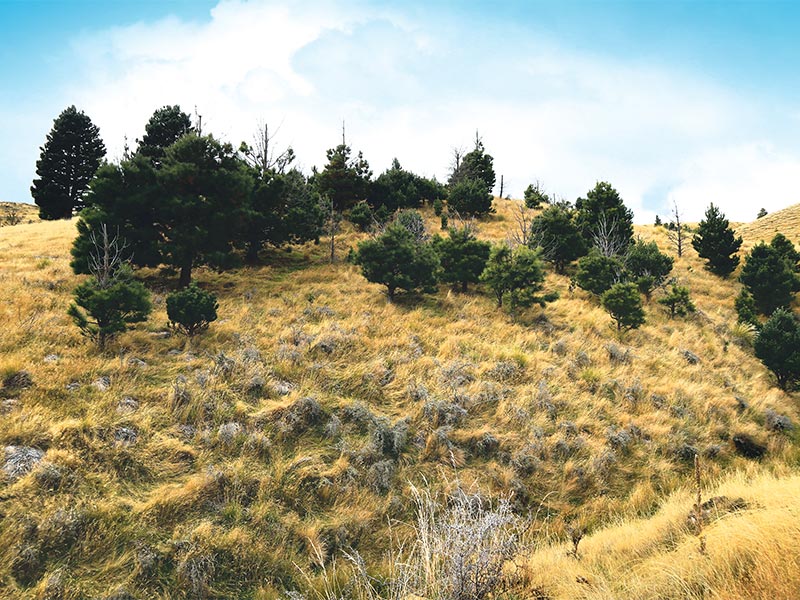Wilding pines: the silent invader
6 min read
Wilding pines are seemingly innocuous trees that have become a formidable threat to New Zealand. Photo: Supplied
In the untamed expanse of New Zealand grows a silent intruder that is slowly encroaching upon the native beauty. While the pine trees may appear majestic to the uneducated eye, self-seeded wilding pines are slowly wreaking havoc on the country’s ecosystem, threatening to permanently alter the unique New Zealand landscape.
Wilding pines are seemingly innocuous trees that have become a formidable threat to New Zealand, with particular spread in the South Island. As the invasive tree spreads, its impact is sending shockwaves across different communities that are demanding immediate attention and action.
According to The Wilding Pine Network, the trees are a significant threat to Aotearoa New Zealand’s biodiversity and ecosystems.
Pines are a valuable asset when managed in commercial forestry plantations but wilding trees are a different story.
“Their negative impacts extend to waterways, people, property, and farmland,” Jo Ritchie, The Wilding Pine Network coordinator, says.
Wilding pines spread fast. Uncontrolled wilding pines have the potential to spread to 7.5 million hectares of vulnerable land, or over 25% of New Zealand’s land area, by 2050 with a devastating impact on the environment, iconic landscapes, and primary industry.
And it’s not just the environment that is at stake; the rate at which wilding pines is growing is also overwhelming farmland, recreational land, and areas of cultural importance.
Glenshee Station owner Peter Hore has been farming in the Maniototo area of Central Otago his entire life. And while he’s seen many changes over the years, the spread of wilding pines across New Zealand’s land is one of his biggest concerns – and one he reckons everyone needs to get clued up on.
Peter is part of a community of locals concerned about wilding pines – trees that have self-seeded and are growing where they are not supposed to.
While growing up in the Maniototo, Peter says they did hear about these troubling trees, although, he says back then it seemed as though the trees never really spread too much.
“People had pointed out that one day the trees were going to be a problem, but I guess we were pretty complacent about it; we didn’t take much notice. That didn’t last long. As we got to the 1980s and 1990s , they really started to grow and move seriously. Winds carried pollen, and it made the ground compatible for the trees to self-sow and take root.
“They moved extremely quickly; there was probably a 10-year period where they went from being just scattered to all of a sudden being a problem.”
By around 2009, Peter got very concerned about the trees and started to speak up.
“They were spreading from a local forestry, and there was one property between us and the forestry, and we were concerned they were coming our way.
“We also had a small conservation reserve right in the middle of our Glenshee property, and the trees were spreading from it; those were our immediate concerns.
“I remember one day, we had a couple of men up there to dig out a few trees, and they came back shaking their heads and said, ‘It’s hopeless. It’s hundreds of trees up there’.”
Come 2013, Peter got involved with the Central Otago Wilding Conifer Control Group.
“That’s when we started seriously controlling them. They were potentially just going to take us over. The trees en masse just closed the canopy right over good, open clean tussock country. That’s what we were worried would happen, but we nailed it before that ever happened.”
Peter and his family were one of the original initiators of bringing the local community together to do something about wilding pines.
“Everyone was quite receptive to it because they could also see what was happening,” Peter says. “And it is their land, and no one farm or station was immune to the spread of the trees and the threat they pose.”
Wilding impact

Jo says the risks and negative impacts of wilding pines outweigh the benefit of the carbon dioxide they can absorb. They can no longer be included in the Emissions Trading Scheme to generate carbon credits.
The Wilding Pine Network says there is a significant threat to waterways, too. High-density wilding pine infestations have the ability to decrease water flow into rivers by 30% to 40%, impacting water-sensitive catchments and reducing available water for irrigation and hydroelectricity generation.
Peter says he has seen the trees take up to 70% of the water out of a catchment.
“I was concerned that it was going to dry up all the waterways. Trees are well known for absorbing the water,” he says. “And you can’t farm without water.”
There are numerous other concerns relating to a concentration of wilding pines within a water catchment area. According to the Wilding Pines Network, the invasive nature of the trees means they can alter waterways such as key braided river catchments while taking the place of other native trees and shrubs that may otherwise occupy these areas.
“For many locations where water sources can be scarce, the impacts are more pronounced as they can also decrease water yield,” says Jo.
“This has a direct impact on the habitat of New Zealand’s flora and fauna, irrigation for productive land and crops, and drinking water.”
Wilding pines can also increase the intensity and impact of wildfires. The more they are able to take root and multiply, the worse the risk becomes.
“Unlike professionally managed commercial forests, wilding pine forests don’t have firebreaks or fire ponds and are often in steep areas that are very difficult to reach. They are also unpruned, and the lower branches can connect short vegetation with the tree canopy in wildfires, leading to fires in the tree canopy that are difficult and dangerous to control,” Jo explains.
Fires in wilding pine forests can burn more vigorously, increasing the threat to adjoining native bush, commercial forests, roading and electricity infrastructure, towns and villages and especially to human life.
Jo says it can no longer be substantiated due to climate and weather changes as well as people.
Funding

Between 2016 and 2021, the National Wilding Conifer Control Programme partnership searched and controlled wilding infestations across over two million hectares of New Zealand. However, any past progress and or future ability to control wilding pines is in jeopardy due to inadequate funding from 2023.
An official report released in September 2018 (Sapere Report – Cost Benefit Analysis) shows the cost to New Zealand of letting wilding pines spread would be catastrophic.
“There’s a significant funding cut coming in the 2023 financial year, which will impact the work of the management group and allow an increased spread of wilding pines, with almost irreversible and adverse outcomes,” Jo says.
“If we do not receive continued funding at least at existing levels of around $25 million per annum for wilding pine control, we will lose the advantages gained from the investment of $137 million that the Government has made over the last five years.
“We will also lose the workforce capability that has been developed and expanded in recent years both in terms of communities, volunteers, landowners, and contractors.”
The battle against wilding pines rages on and the tide could possibly be turned through collaborative efforts, education, and proactive measures.
Peter says raising awareness of the wilding pines issue is important not just for farmers who are at risk of losing their livelihoods but also communities as a whole.
“People are generally aware of the issue but not active. Some of them just say, ‘We’ve heard about this, but it’s not our problem’. And they just stand back and grandstand and look,” he says.
“I’ve been in places where the trees are so thick you couldn’t even get on your hands and knees and crawl through them.
“If we can get all the seed source out of the ground, then we only have the spread to deal with. But at the moment, the spread has become established, and the spread is becoming a source.”



